
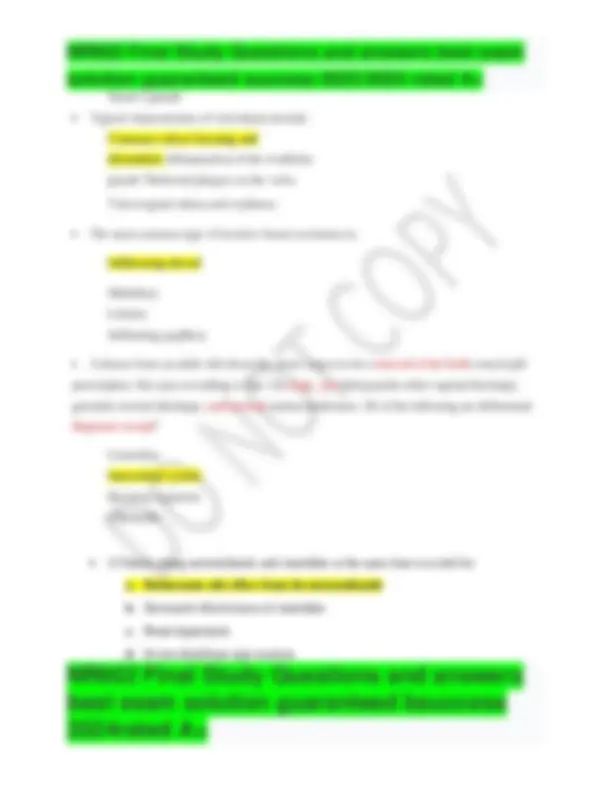
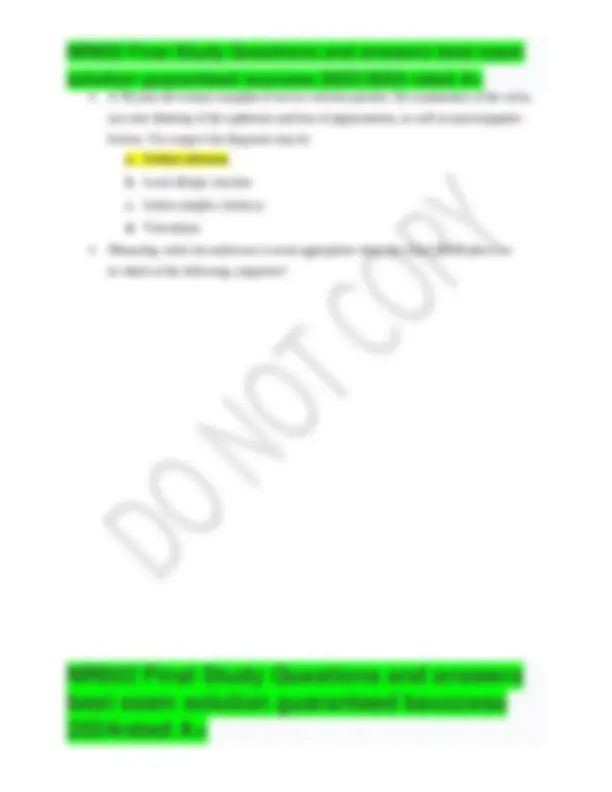
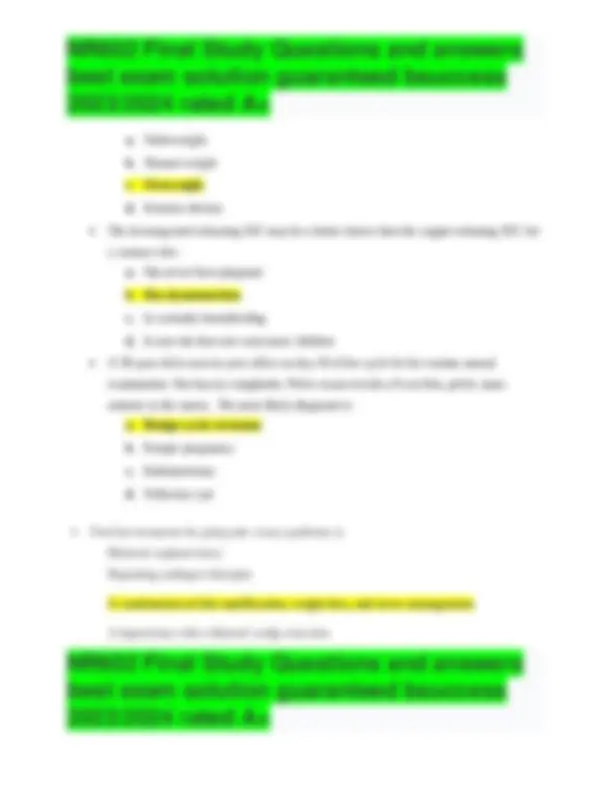
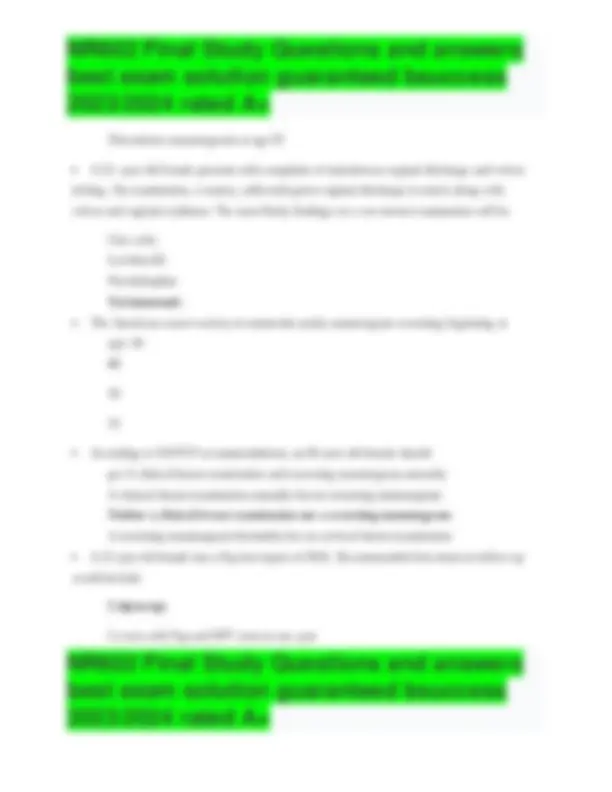
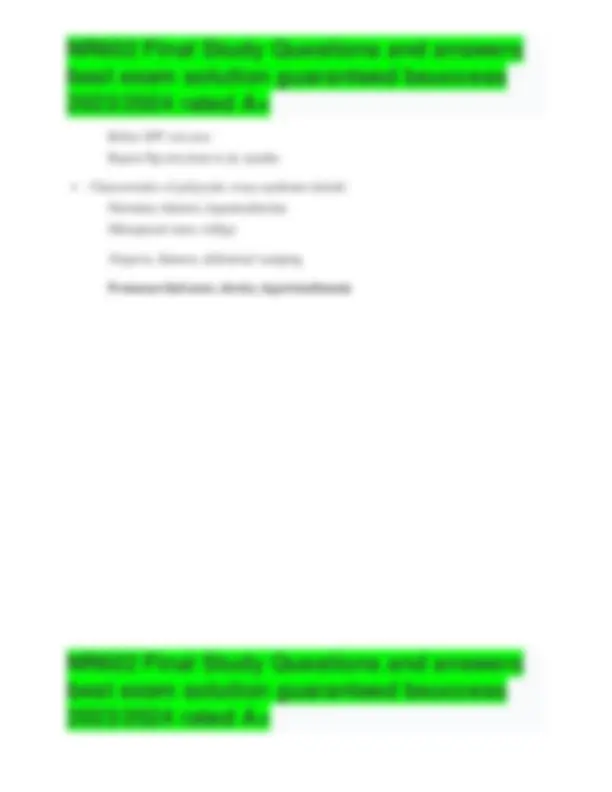
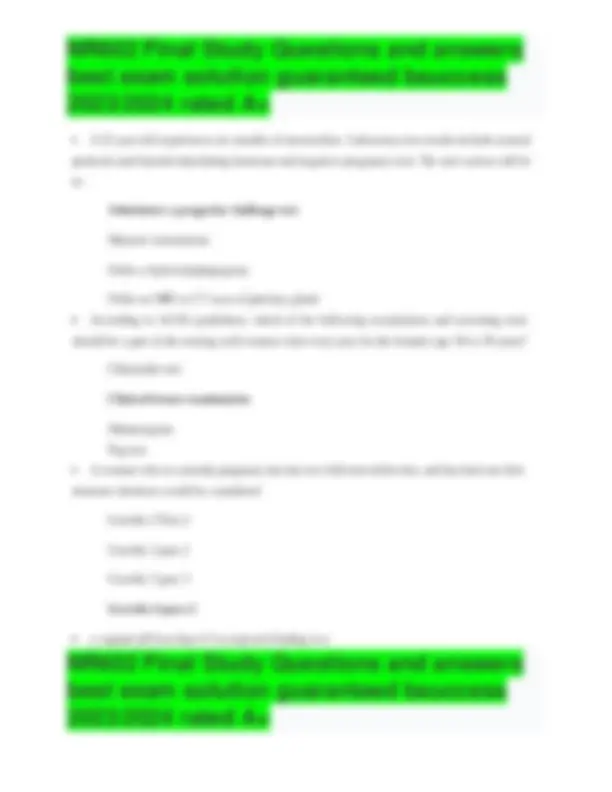
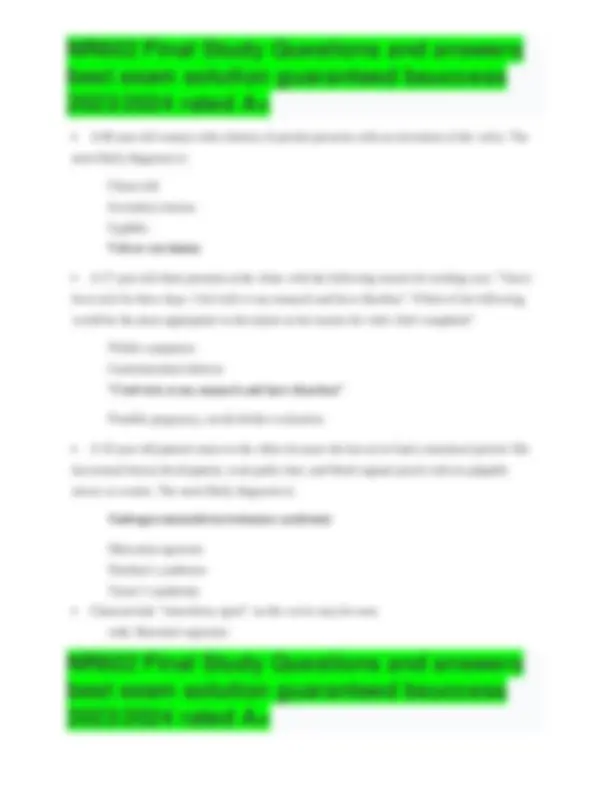

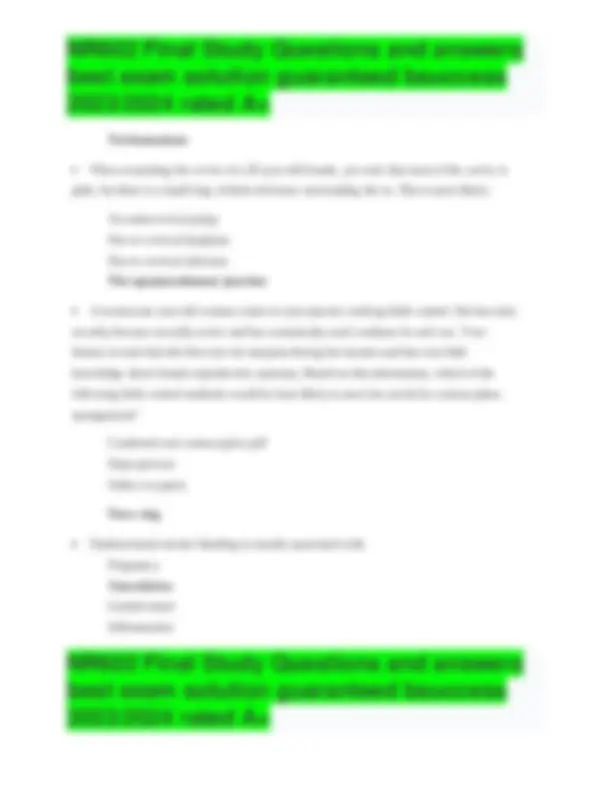
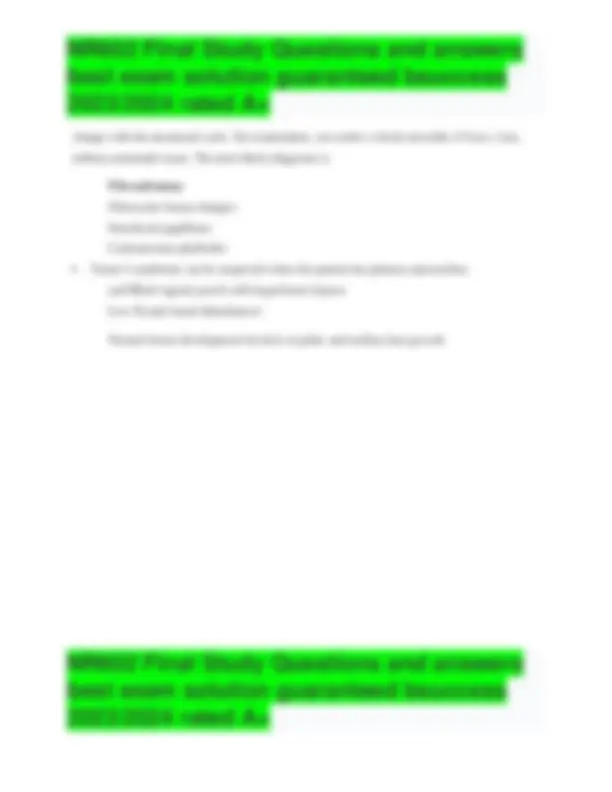
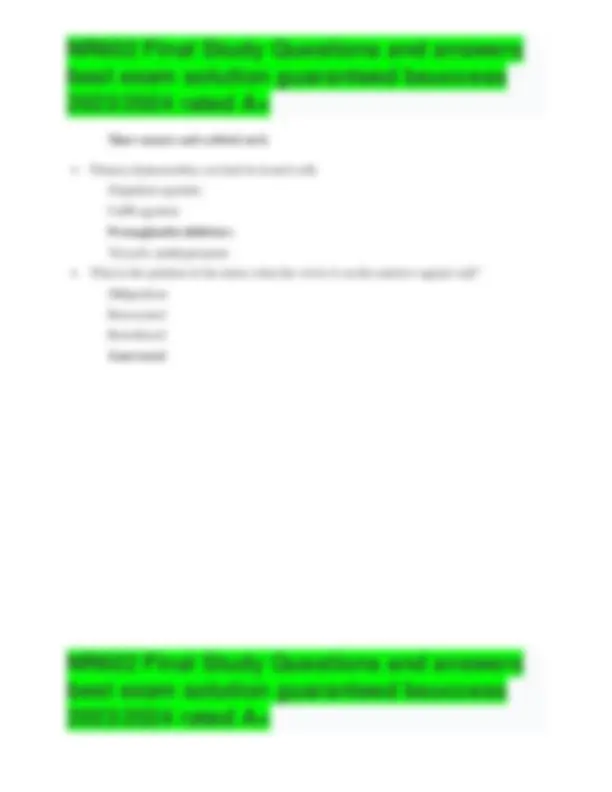


Study with the several resources on Docsity

Earn points by helping other students or get them with a premium plan


Prepare for your exams
Study with the several resources on Docsity

Earn points to download
Earn points by helping other students or get them with a premium plan
Community
Ask the community for help and clear up your study doubts
Discover the best universities in your country according to Docsity users
Free resources
Download our free guides on studying techniques, anxiety management strategies, and thesis advice from Docsity tutors
Final study questions and answers for a reproductive health and contraceptives course. The questions cover various topics such as contraceptive methods, female reproductive system disorders, and breast health. Students are encouraged to use this resource to prepare for exams.
Typology: Exams
1 / 19

This page cannot be seen from the preview
Don't miss anything!












Final Study Questions A sexually active 18-years old presents with postcoital spotting, dysuria and a yellow discharge. On exam you find her cervix is erythematous and bleeds with contact. The most likely diagnosis is a. Cervical cancer b. Chlamydia c. Primary syphilis d. Tampon injury One of the leading causes of female infertility, Stein-Leventhal syndrome is a. Pelvic inflammatory disease b. Polycystic ovary disease c. Multiple sex partners d. Ectopic pregnancy syndrome HIV test is indicated for a (n) a. 18-year-old female whose sex partner has a history of genital warts b. 24-year-old female with current genital warts as adjunct to routine pap test c. 30-year-old female with no history of genital warts as adjunct to routine pap test d. 67-year old female with new sex partner in past year who has history of genital warts Which of the following contraceptive methods would be best for a woman with sickle cell anemia? a. Combination oral contraceptives b. Transdermal contraceptive patch c. Progestin-only contraceptives
d. Female condom A 24-year old female presents to your office with a request for combination contraceptives. Her current medications include a bronchodilator for asthma. Management for this client should include advising her that: Combination oral contraceptives are not recommended for women with asthma Combination oral contraceptives may potentiate the action of her bronchodilator She should use a backup method if using the bronchodilator several days in a row Progestin-only contraceptive injections may reduce her asthma attacks The CDC recommendation for follow-up of a female treated for PID with a recommended outpatient regimen is: Advise patient to return if pain and/or fever persists more than five days Re-examine patient within 72 hours after initiation of treatment Retest for chlamydia and gonorrhea in two weeks See patient in one week for second dose ceftriaxone IM A 16-year old woman has not yet begun menstruating but does have secondary sexual characteristics. She is best described as having: Asherman’s syndrome Oligomenorrhea Primary amenorrhea Secondary amenorrhea The glands located posteriorly on each side of the vaginal orifice are the: Bartholin’s glands Bulbar glands Natorian glands
A 58-year old woman complain of severe vulvular pruritis. On examination of the vulva, you note thinning of the epidermis and loss of pigmentation, as well as maculopapular lesions. You suspect the diagnosis may be a. Lichen sclerosus b. Local allergic reaction c. Lichen simplex chonicus d. Vulvodynia Measuring waist circumference is most appropriate when the client’s BMI place her in which of the following categories?
a. Underweight b. Normal weight c. Overweight d. Extreme obesity The levonogestrel releasing IUC may be a better choice then the copper releasing IUC for a woman who: a. Has never been pregnant b. Has dysmenorrhea c. Is currently breastfeeding d. Is sure she does not want more children A 30-year old is seen in your office on day 18 of her cycle for her routine annual examination. She has no complaints. Pelvic exam reveals a 9-cm firm, pelvic mass anterior to the uterus. The most likely diagnosis is a. Benign cystic teratoma b. Ectopic pregnancy c. Endometrioma d. Follicular cyst First line treatment for polycystic ovary syndrome is Bilateral oophorectomy Beginning androgen therapies A combination of diet modification, weight loss, and stress management A laparotomy with a bilateral wedge resection
Trichomoniasis Chlamydia A 26-year old woman presents with multiple painless, umbilicated papules on her mons pubis. The most likely diagnosis is: Condyloma acuminate Condyloma lata Lumphogranuloma venereum Molluscum contagiosum A 26- year old female has a Pap test report of ASC-US. This is her first abnormal Pap test. Recommended first steps in follow- up would include: Colposcopy within the next six months Co-testing with Pap and HPV tests in one year Reflex HPV now Repeat Pap test alone in three years USPSTF recommendations for routine breast cancer screening include: Biennial mammograms starting at age 50 Breast self-examination starting at age 21 Clinical breast examination annually starting at age 30
Discontinue mammograms at age 65 A 22- year old female presents with complaint of malodorous vaginal discharge and vulvar itching. On examination, a watery, yellowish-green vaginal discharge is noted, along with vulvar and vaginal erythema. The most likely findings on a wet mount examination will be: Clue cells Lactobacilli Pseudohyphae Trichomonads The American cancer society recommends yearly mammogram screening beginning at age: 40 45 50 55 According to USPSTF recommendations, an 80 year old female should get A clinical breast examination and screening mammogram annually A clinical breast examination annually but no screening mammogram Neither a clinical breast examination nor a screening mammogram A screening mammogram biennially but no cervical breast examination A 22 year old female has a Pap test report of HSIL. Recommended first stems in follow up would include: Colposcopy Co-test with Pap and HPV tests in one year
A 22 year old experiences six months of amenorrhea. Laboratory test results include normal prolactin and thyroid stimulating hormone and negative pregnancy test. The next action will be to: Administer a progestin challenge test Measure testosterone Order a hysterosalpingogram Order an MRI or CT scan of pituitary gland According to ACOG guidelines, which of the following examination and screening tests should be a part of the routing well-woman visit every year for the females age 30 to 39 years? Chlamydia test Clinical breast examination Mammogram Pap test A woman who is currently pregnant, has has two full-term deliveries, and has had one first trimester abortion would be considered Gravida 2 Para 2 Gravida 3 para 2 Gravida 3 para 3 Gravida 4 para 2 a vaginal pH less than 4.5 is expected finding in a
Healthy reproductive age woman Menopausal woman with atropic vaginitis Reproductive age woman with trichomoniasis Healthy prepubertal age girl
A 66 year old woman with a history of pruritis presents with an ulceration of the vulva. The most likely diagnosis is: Chancroid Secondary trauma Syphilis Vulvar carcinoma A 17 year old client presents at the clinic with the following reason for seeking care: “I have been sick for three days. I feel sick to my stomach and have diarrhea”. Which of the following would be the most appropriate to document as her reason for visit/ chief complaint? Flulike symptoms Gastrointestinal distress “I feel sick to my stomach and have diarrhea” Possible pregnancy, needs further evaluation A 16 year old patient comes to the office because she has never had a menstrual period. She has normal breast development, scant pubic hair, and blind vaginal pouch with no palpable uterus or ovaries. The most likely diagnosis is: Androgen insensitivity/resistance syndrome Muscarian agenesis Sheehan’s syndrome Turner’s syndrome Characteristic “strawberry spots” on the cervix may be seen with: Bacterial vaginosis
Chlamydia Herpes genitalis
Pelvic findings on examination of a 22- year old nulliparous woman is uterus 7cm in length and ovaries 3cm x 2cm x 1cm. These findings are consistent with Enlarged uterus and enlarged ovaries Normal size uterus and enlarged ovaries Enlarged uterus and normal size ovaries Normal size uterus and normal size uterus In a premenopausal woman, the biggest heart attack risk factor is Cigarette smoking Family History
Sedentary lifestyle Obesity Iris is a 32 y/o married woman with three children. She comes in for information on using copper T IUD for contraception. Which of the following would be a contraindication to using this appliance? Nulliparity Heart disease Prior ectopic pregnancy history of multiple births A nurse practitioner is screening a female for prescribing contraception fir the first time. Which of the following is an absolute contraindication for estrogen-containing contraception? Migraine headaches Hypertension Theomboembolisms Seizure disorder Mrs. Jackson, age 37, has been on birth control pills for approximately 15 years. She is a smoker, has a blood pressure of 110/70mmHg and has lipid levels within normal limits. You advise that she should Discontinue the birth control pills because of smoking A 24 year old woman presents with complaint of nontender mass in her breast that does not
Short stature and webbed neck Primary dysmenorrhea can best be treated with Dopamine agonists GnRh agonists Prostaglandin inhibitors Tricyclic antidepressants What is the position of the uterus when the cervix is on the anterior vaginal wall? Midposition Retroverted Retroflexed Anteverted